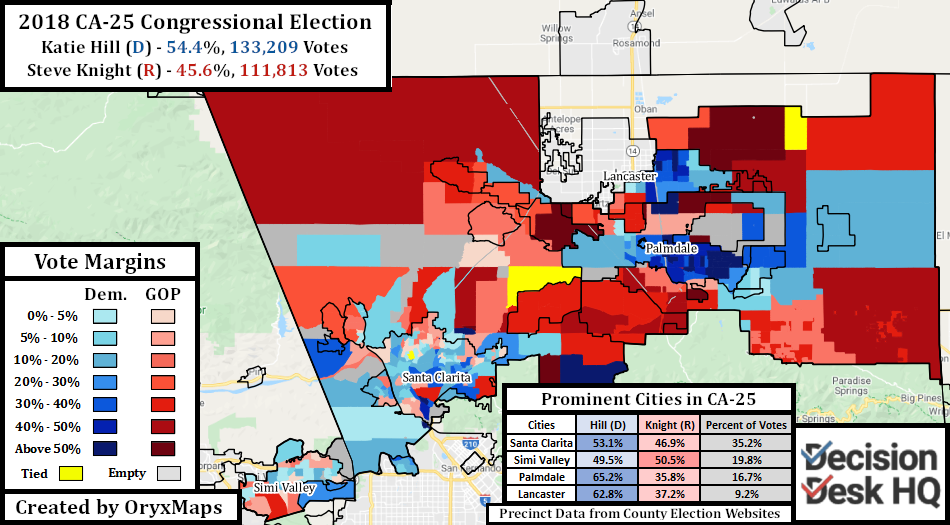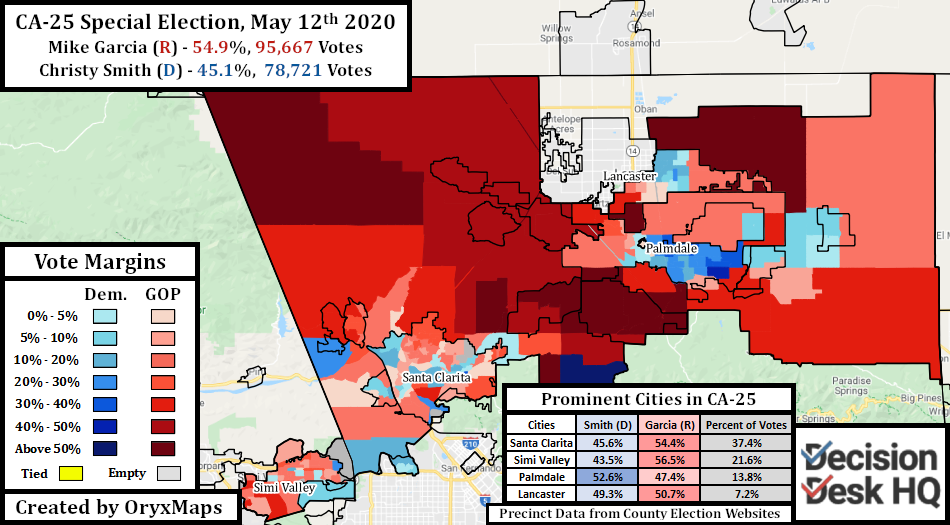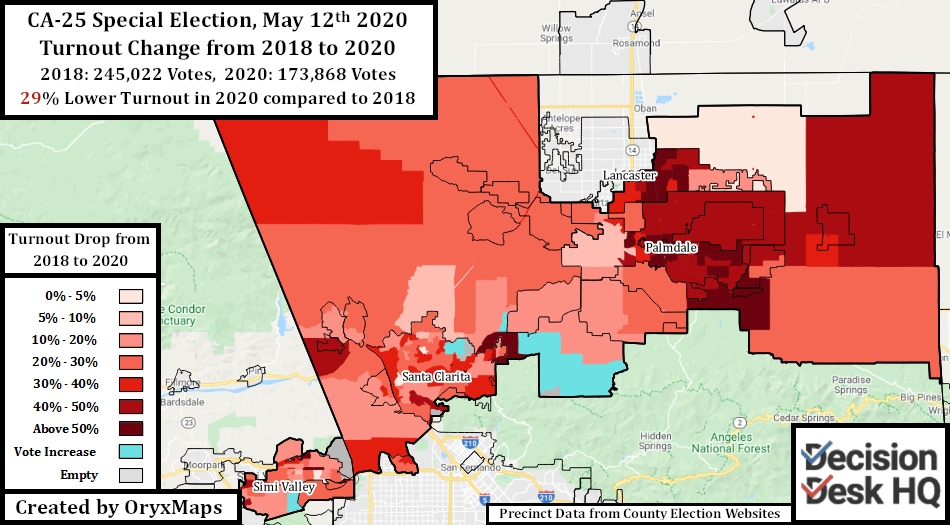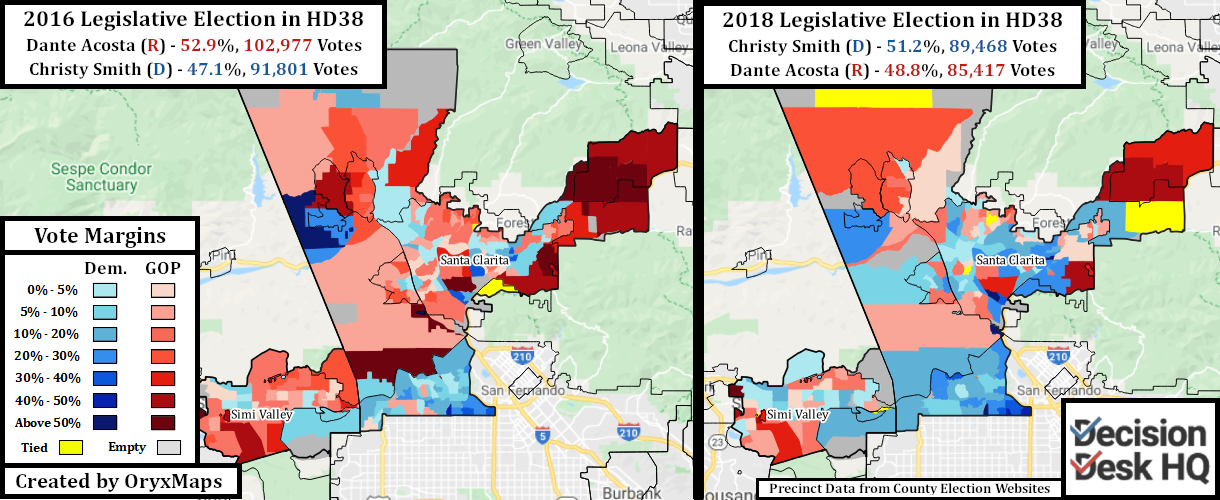Democratic insiders did not expect to lose the 2020 special election for California’s 25th district. Since 2016, the presidential topline, voter registration statistics, and the demographic makeup of CA-25’s voter pool increasingly favor the Democratic party. Republican Mike Garcia navigated his way to a special election victory, but he faces significant obstacles to winning a full term in Congress. DDHQ recently moved CA-25 out of the Toss Up category, and we believe the Democrat Christy Smith is favored to win. Cook Political believes the seat to be a Toss Up, and all ratings sites expect a close race, including the recently released 538 House model. Garcia has some advantages of incumbency, but the electorate expected to turn out in November will not resemble the one that sent Garcia to Congress.
CA-25 is best understood as two communities joined by a mountain range, the expensive Los Angeles media market, and a shared cultural identity distinct from the urban Los Angeles basin. About 45% of residents live in Palmdale, Lancaster, and the rest of the Antelope Valley, and 54% live in or around the suburban communities of Simi Valley and Santa Clarita. The areas which incorporated as Santa Clarita and Simi Valley boomed with suburban growth in the 1960s and 1970s. White families moved into these suburbs from Los Angeles, bringing wealth and opportunity with them. The Antelope Valley on the other hand experienced its growth surge after 1985. Exurban developers built up the Antelope Valley during the 1980s, but the decline of the area’s large aerospace industry at the end of the Cold War deflated its real estate bubble. Lower income minority commuters took advantage of the cheap housing, transforming the demographics of Palmdale, Lancaster, and their environs.
Today the Antelope Valley is majority-minority, with significant Hispanic and African American populations. The older suburbs closer to Los Angeles are majority or plurality White, with integrated Hispanic and Asian minority communities. The average household income in the district’s suburban southwest is approximately $95K, almost $30K-$40K more than in the Antelope Valley. Approximately 15% of Antelope Valley residents have a college education while approximately 35% of Santa Clarita and 33% of Simi Valley have Bachelor’s degrees or higher. Politically, the Antelope Valley favors the Democrats whereas Santa Clarita backed Republicans until 2016, and Simi Valley has never voted for a Democratic Presidential ticket.

Democrats began paying attention to CA-25 in 2016. Obama only lost the district by 2% in 2012, and polling data suggested that Clinton would perform better in districts demographically similar to CA-25. Democrats threw resources behind lawyer Brian Caforio in an attempt to oust the incumbent Republican freshman Steve Knight. Clinton carried the district by 6.7%, or 50.3% to 43.6%, but it wasn’t enough to push Caforio over the finish line. Knight leveraged the region’s distrust of urban Los Angeles, and attacked Caforio over his recent relocation to Santa Clarita. Knight won by 6.2%.

Heading into the 2018 midterm elections, the path to a Democratic congressional majority ran through CA-25 and other Republican districts that Clinton won in 2016. Katie Hill, the bisexual nonprofit executive of People Assisting the Homeless, emerged from the contentious blanket primary as the Democratic nominee against Knight. Hill lapped the incumbent in fundraising and outflanked him on cultural issues – all while pulling in young activists from the Los Angeles Basin. Despite trailing Knight in two of New York Times’ live polls, Hill won by 8.8%. Hill led in votes counted on election night – the Democrat-favoring mail ballots counted later just widened her margin.

Katie Hill’s personal life became national news, forcing her to resign in October 2019. She resigned after allegations of congressional affairs, compounded by Conservative blog RedState leaking nudes, led to the House Ethics Committee opening an investigation. A dozen candidates filed for the special election to replace Hill, including former Representative Steve Knight and progressive political commentator Cenk Uygur. Democrat Christy Smith, the current representative for California Assembly District 38, and Republican Mike Garcia, a former navy pilot and Iraq war veteran, won the top-two primaries to be the candidates in the May special election and the 2020 November general election. Garcia was sworn into Congress on May 19th after winning the special election by 9.8%, or 54.9% to Smith’s 46.1%.

Garcia’s problem is that his special election victory may not translate to the general election electorate. The California voter pool gets whiter the more an election diverges from the normal date. The special election electorate favored Republicans to a degree unseen previously in this district. Turnout dropped by over 50% in precincts with large numbers of Hispanics and African Americans, such as the cities of Palmdale and Lancaster; but turnout only fell by 20% in Republican Simi Valley. Democrats have a 7.5% Party Identification edge in CA-25 due to their work among minority communities, but more registered Republicans cast votes in the special election than Democrats. The California electorate is most diverse during Presidential elections, which means more turnout and more votes from demographic groups likely opposed to Mike Garcia.
Perhaps this is why Garcia is not behaving like a Republican running for reelection in a Democratic seat. Garcia toes the party line in Congress far more than other Congressmen in his electoral position, voting the GOP line 90% of the time. Garcia voted against the Democratic USPS rescue and against condemning anti-Asian COVID-19 rhetoric – both bills backed by other vulnerable Republicans. Garcia loyally backs Trump’s policies on his website, and he has appeared next to the President in Washington. The Congressional Leadership Fund still believes Garcia can overcome his conservatism: the PAC recently invested $750K on top of a previous fall CA-25 ad buy of $1.8 million.

Despite her May loss to Garcia, Christy Smith is not a weak or inexperienced candidate. Before Smith ran for the California Assembly, she worked for Bill Clinton’s Department of Education, her local School Board, and the proposition campaign to raise bond money for Santa Clarita schools. Her campaigns for Assembly District 38 in 2016 and 2018 mirror the voting patterns of CA-25, even though AD38’s baseline partisanship favors Republicans by 1% more than the Congressional district. Smith lost a close race for the open seat in 2016 by 5.8%, then won the 2018 rematch with Republican Dante Acosta by 2.4%. Smith followed her passions and now serves on the Assembly Education Committee in Sacramento. The theme of education carried over to her campaigns for CA-25: her campaign website’s first priorities are reducing class sizes, increasing teacher pay, and reducing college tuition.
Republicans believe that they can link Christy Smith’s legislative career with actions taken by the Democratic trifecta in Sacramento. It is a standard tactic of the California GOP to tie their Democratic opponents to liberal ballot initiatives to attract crossover votes. This year, state Republicans, including Mike Garcia, are running against state Assembly Bill 5 and in favor of 2020’s California Proposition 22. AB5 reclassified gig workers (e.g. Uber drivers) as employees, requiring companies to provide employment benefits under California law, and allows for potential unionization. Proposition 22 seeks to carve out an exemption for app-based companies that would avoid the employee classification but still provide some benefits. Support for Proposition 22 leads in polls by a plurality, and rideshare companies have blanketed the state with $180 million of ads in favor of Proposition 22. Mike Garcia’s ads connect Christy Smith to AB5 through her legislative work. Recent California history casts doubt on the success of these tactics. The GOP ran against California’s gas tax and for Proposition 6 in 2018, but the party lost legislators at every level of government.
Traditional campaign metrics aren’t saving Garcia. During the special election, Garcia and Republican PACs outspent Christy Smith and the DCCC by over $1 million. This advantage persists: Christy Smith raised $1.34 Million over the last three months, but Garcia raised $3.2 million during the same period. Despite her cash deficit, recent polling continues to favor Smith. Normington, Petts & Associates has Smith leading by 6%, and Breakthrough Campaigns has her leading by 2%. Both were Democratic internals, but Garcia did not try to blunt their narrative by releasing a Republican internal, the normal tactic for candidates in close races. As seen by the New York Times’ 2018 polls, polling in the American Southwest has trouble predicting Hispanic turnout and party support. Given the number of Hispanic voters in CA-25, and the fact that the DCCC is running ads specifically to boost Hispanic turnout, Garcia could be in an even worse position than he appears.
The electorate will not be as demographically favorable to Garcia as it was in May. Garcia has not attempted to appeal to CA-25’s diverse demographic groups, and instead is counting on the those that backed him in May. With Biden at the top of the ticket it is unlikely that Garcia will get the crossover support he needs to win a full term in Congress. California voters are already mailing in their ballots, and Garcia is running out of time to change the trajectory of this race.
Ben Lefkowitz (@OryxMaps) is a Contributor to Decision Desk HQ.